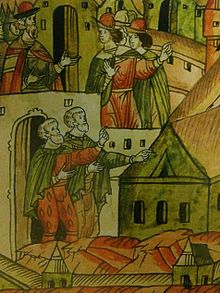Pietro Antonio Solari

Pietro Antonio Solari (
Biography
He was born in Carona and apprenticed under his father Guiniforte Solari, who was the leading architect of the Duomo di Milano.[3] In his father's workshop, he learned to draw plans and sculpture statues.[3] In 1476, he was hired to contribute to the construction of the Duomo di Milano. At 26, he was appointed a deputy of his father by the Duke of the Duchy of Milan.[3] When his father died, he was appointed his successor for the buildings of the Duke but not at the Catherdral of Milan.[4] Later he also sculpted a tomb of the bishop Marco de Capitani in the Cathedral of Alessandria.[3]
In 1487, he was invited to Russia by
On top of the Spasskie Gates there was inscribed the following inscription:
IOANNES VASILII DEI GRATIA MAGNUS DUX VOLODIMERIAE, MOSCOVIAE, NOVOGARDIAE, TFERIAE, PLESCOVIAE, VETICIAE, ONGARIAE, PERMIAE, BUOLGARIAE ET ALIAS TOTIUSQ(UE) RAXIE D(OMI)NUS, A(N)NO 30 IMPERII SUI HAS TURRES CO(N)DERE F(ECIT) ET STATUIT PETRUS ANTONIUS SOLARIUS MEDIOLANENSIS A(N)NO N(ATIVIT) A(TIS) D(OM)INI 1491 K(ALENDIS) M(ARTIIS) I(USSIT) P(ONERE).[5]
Together with Marco Ruffo, Solari also built the Palace of Facets in the Kremlin.
He died in Moscow in May 1493. The Fryazin title originates from the old Russian word фрязь (fryaz), derived from frank, that was used to denote people from Northern Italy.
Notes
- ^ Z. Davidov. Stars on the towers. (Звезды на башнях) Moscow, 1963
- ISBN 9781136808005.
(Borovitskaya Tower) It was built in 1490 and its architect was Pietro Antonio Solari. He was one of those Italian architects and urban engineers invited by the Great Duke of Muscovy, Ivan the Third to participate in the reconstruction of the Moscow Kremlin.
- ^ ISBN 978-3-907291-21-4. Retrieved 20 August 2022.
- ^ Stalder, Helmut (2020),p.46
- ^ "O.A. Belobrova. Latin inscription on the Frolov Spasskie gates of the Moscow Kremlin and its fate in the Old Russian literacy. GMMK. Materials and researches. New attributions. 1987, issue 5. p.51-57" (PDF). Archived from the original (PDF) on 18 July 2011. Retrieved 29 December 2009.
References
- Arte e artisti dei laghi lombardi. Como: Noseda. 1959.
